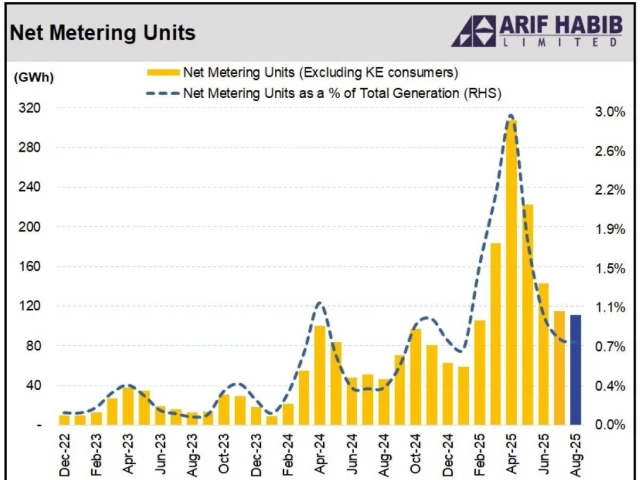Chart illustrating the share of net metering in total generation, reflecting the increased adoption of solar energy and decreasing dependence on the grid. Source: NEPRA, AHL research
If your electricity bill went up in August even though your roof is covered in solar panels, you can blame Mother Nature for the price, but only up to a point. It was hot, the sun was shining, but you still ended up paying K-Electric for mains electricity.
For example, my house is 1,100 square feet and half of the roof has solar panels. In August our solar production was 1,304 kWh (kilo watt hours) and we ended up paying a much higher bill than usual. Compare that to September, when our generation increased to 1,503 kWh and our bill decreased.
Solar’s contribution to Pakistan’s grid declined in August. It provided just 0.7% of the total 14,218 GWh (gigawatt hours) produced that month, according to research firm Arif Habib Ltd.
“This August has seen heavy rains and solar production depends on sunshine levels,” said Dr Javed Iqbal, director of the Institute of Space and Planetary Astrophysics at the University of Karachi. “So the main culprit for poor solar production was cloud cover.”
Read: Pakistan’s solar boom causes water stress, budget woes
Sindh’s overcast skies, high temperatures and discrepancies in the way solar energy is reported are therefore the cause. “We’re seeing an increase in solar production in September, and we’ve also seen an overall decrease in cloud cover,” he added. “It is therefore safe to say that low solar output is mainly attributed to higher cloud cover.”
Rainy days
August 20 and 21 were the rainiest days on record in Karachi. The weather station at the old Karachi airport terminal, for example, recorded 163.5 mm, the highest rainfall seen in this region since 1979, according to Anjum Nazir, spokesperson for the Sindh meteorological department. The lowest rainfall was recorded in Bahria and Orangi towns at 5mm and 81mm respectively. The highest rainfall recorded in the city during these two days was
Heavy rain decreases solar irradiation or the strength of sunlight received by a surface per unit area. Low radiation reduces photovoltaic – solar production. This means that the type of clouds above an area can affect the strength of sunlight. Thick monsoon clouds decrease irradiation in high percentages.
Safety valves
Most residents of Karachi faced power outages during the monsoon. This is due to what is called “standard anti-islanding protection”. This is a safety mechanism that prevents an energy source from supplying the network when the network is down. Grid-connected inverters shut down during a grid power outage. Rooftop panels stopped exporting energy to the grid and stopped serving homes until the grid stabilized, further reducing solar production.
Heat and dust levels
High heat levels also affect the efficiency of your solar panel operation. A group of researchers from Chengdu University of Technology and Imperial College London explain how the environment affects solar PV production. The panels lose about 0.5% per degree Celsius, limiting their productivity in hotter climates. This may be a smaller factor than cloud cover and outages, but it still affects midday solar yields.
The researchers also point out that atmospheric conditions, such as pollutants and dust, can reduce solar energy production. They can reduce solar production by up to 60%.
Underestimated solar production
In a conversation with a power company executive, I learned that there are two aspects to solar generation: behind-the-meter metering (BTM) and net metering.
“BTM is when a customer uses solar generation solely for self-consumption. No prior authorization is required for installation, nor are there any regulatory requirements for this to be reported,” he said.
According to an energy overview by REN21, a global network focused on creating renewable energy, a growing share of Pakistan’s solar boom is undocumented because in buildings with newer solar connections, when the electricity goes out, the building relies on solar energy to operate directly. Although this affects measured solar output, the difference it would make is minimal, as this effect persists from month to month and would not only reduce August’s measured output.




